Berg J.M., Tymoczko J.L., Stryer L. Biochemistry
Подождите немного. Документ загружается.

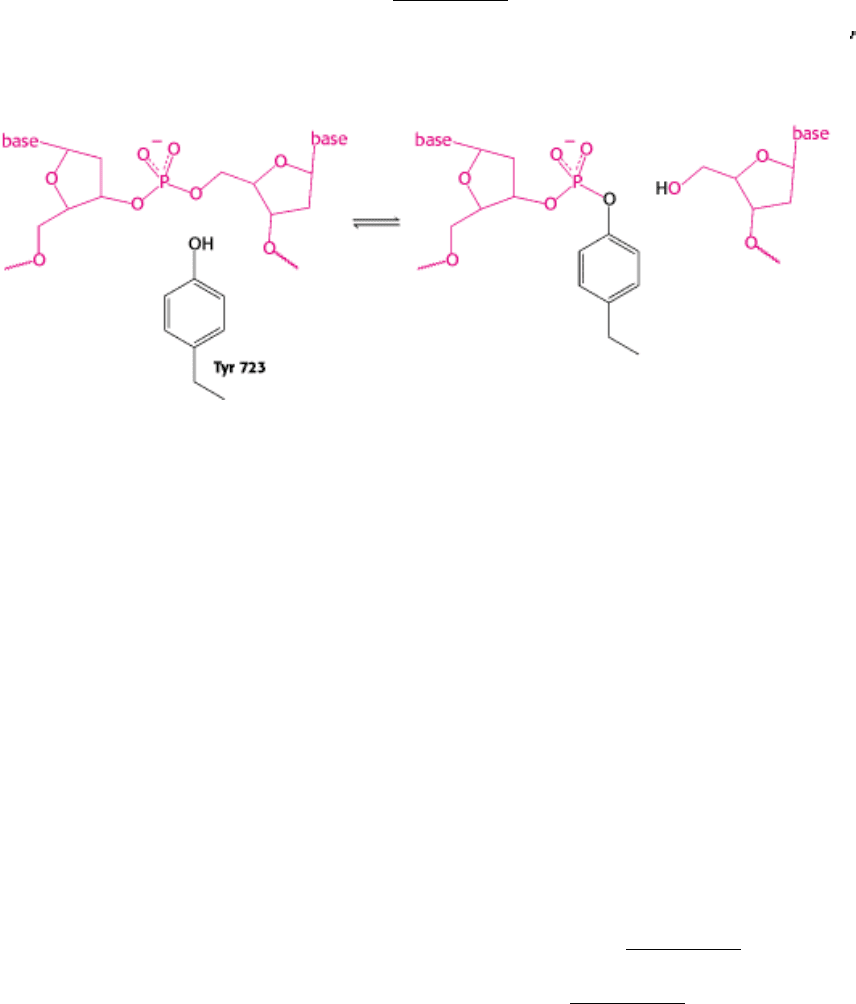
molecules are known to proceed in the following manner (Figure 27.22). First, the DNA molecule binds inside the cavity
of the topoisomerase. The hydroxyl group of tyrosine 723 attacks a phosphate group on one strand of the DNA backbone
to form a phosphodiester linkage between the enzyme and the DNA, cleaving the DNA and releasing a free 5
-hydroxyl
group.
With the backbone of one strand cleaved, the DNA can now rotate around the remaining strand, driven by the release of
the energy stored because of the supercoiling. The rotation of the DNA unwinds supercoils. The enzyme controls the
rotation so that the unwinding is not rapid. The free hydroxyl group of the DNA attacks the phosphotyrosine residue to
reseal the backbone and release tyrosine. The DNA is then free to dissociate from the enzyme. Thus, reversible cleavage
of one strand of the DNA allows controlled rotation to partly relax supercoiled DNA.
27.3.4. Type II Topoisomerases Can Introduce Negative Supercoils Through Coupling
to ATP Hydrolysis
Supercoiling requires an input of energy because a supercoiled molecule, in contrast with its relaxed counterpart, is
torsionally stressed. The introduction of an additional supercoil into a 3000-bp plasmid typically requires about 7 kcal
mol
-1
.
Supercoiling is catalyzed by type II topoisomerases. These elegant molecular machines couple the binding and
hydrolysis of ATP to the directed passage of one DNA double helix through another that has been temporarily cleaved.
These enzymes have several mechanistic features in common with the type I topoisomerases.
The topoisomerase II from yeast is a heart-shaped dimer with a large central cavity (Figure 27.23). This cavity has gates
at both the top and the bottom that are crucial to topoisomerase action. The reaction begins with the binding of one
double helix (hereafter referred to as the G, for gate, segment) to the enzyme (Figure 27.24). Each strand is positioned
next to a tyrosine residue, one from each monomer, capable of forming a covalent linkage with the DNA backbone. This
complex then loosely binds a second DNA double helix (hereafter referred to as the T, for transported, segment). Each
monomer of the enzyme has a domain that binds ATP; this ATP binding leads to a conformational change that strongly
favors the coming together of the two domains. As these domains come closer together, they trap the bound T segment.
This conformational change also forces the separation and cleavage of the two strands of the G segment. Each strand is
joined to the enzyme by a tyrosine-phosphodiester linkage. Unlike the type I enzymes, the type II topoisomerases hold
the DNA tightly so that it cannot rotate. The T segment then passes through the cleaved G segment and into the large
central cavity. The ligation of the G segment leads to release of the T segment through the gate at the bottom of the
enzyme. The hydrolysis of ATP and the release of ADP and orthophosphate allow the ATP-binding domains to separate,
preparing the enzyme to bind another T segment. The overall process leads to a decrease in the linking number by two.
The degree of supercoiling of DNA is thus determined by the opposing actions of two enzymes. Negative supercoils are
introduced by topoisomerase II and are relaxed by topoisomerase I. The amounts of these enzymes and their activities
are regulated to maintain an appropriate degree of negative supercoiling.

The bacterial topoisomerase II (often called DNA gyrase) is the target of several antibiotics that inhibit the
prokaryotic enzyme much more than the eukaryotic one. Novobiocin blocks the binding of ATP to gyrase.
Nalidixic acid and ciprofloxacin, in contrast, interfere with the breakage and rejoining of DNA chains. These two gyrase
inhibitors are widely used to treat urinary tract and other infections. Camptothecin, an antitumor agent, inhibits human
topoisomerase I by stabilizing the form of the enzyme covalently linked to DNA.
III. Synthesizing the Molecules of Life 27. DNA Replication, Recombination, and Repair 27.3. Double-Stranded DNA Can Wrap Around Itself to Form Supercoiled Structures
Figure 27.19. Linking Number. The relations between the linking number (Lk), twisting number (Tw), and writhing
number (Wr) of a circular DNA molecule revealed schematically. [After W. Saenger, Principles of Nucleic Acid
Structure (Springer-Verlag, 1984), p. 452.]
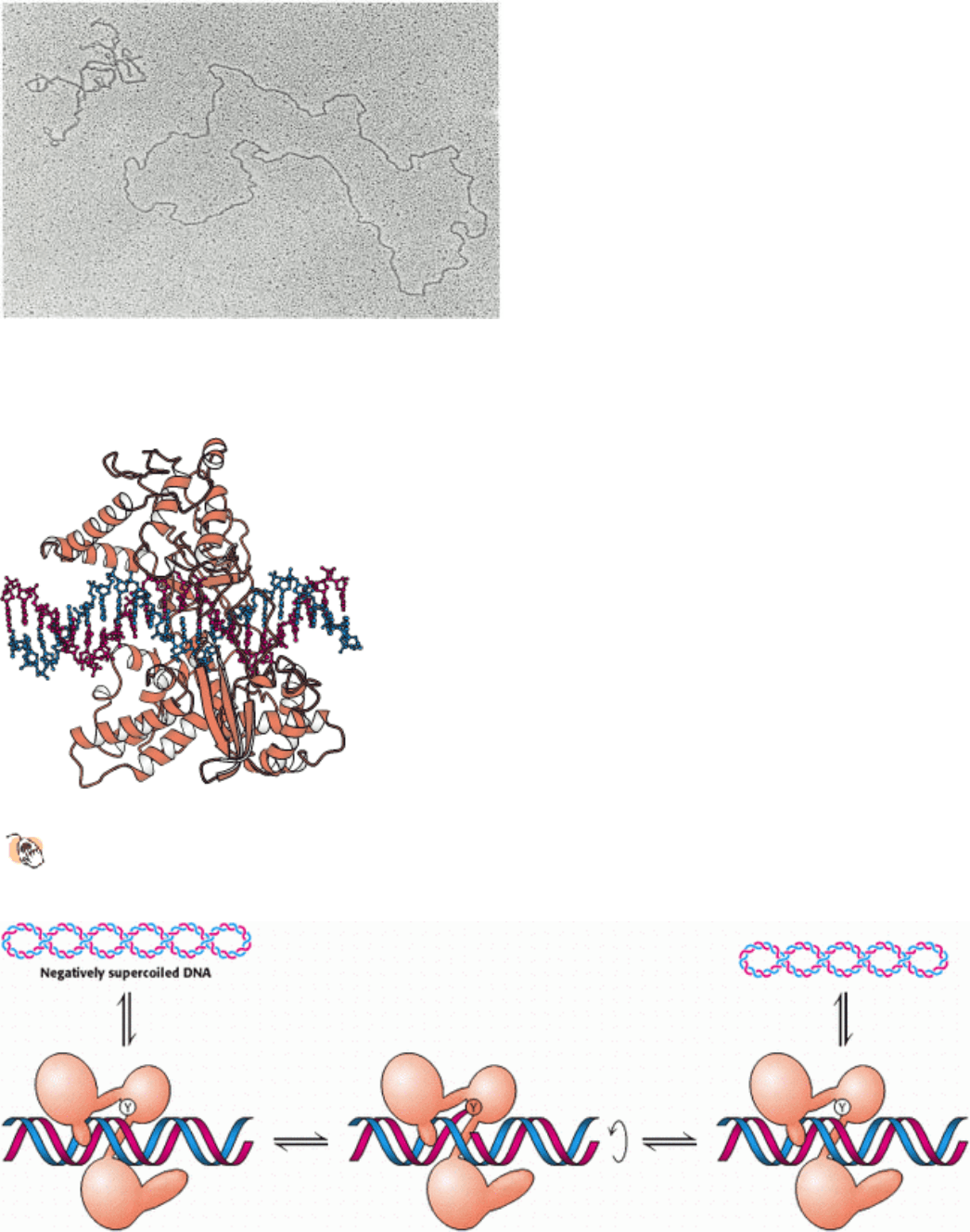
III. Synthesizing the Molecules of Life 27. DNA Replication, Recombination, and Repair 27.3. Double-Stranded DNA Can Wrap Around Itself to Form Supercoiled Structures
Figure 27.20. Topoisomers. An electron micrograph showing negatively supercoiled and relaxed DNA. [Courtesy of
Dr. Jack Griffith.]
III. Synthesizing the Molecules of Life 27. DNA Replication, Recombination, and Repair 27.3. Double-Stranded DNA Can Wrap Around Itself to Form Supercoiled Structures
Figure 27.21. Structure of a Topoisomerase.
The structure of a complex between a fragment of human topoisomerase I
and DNA.
III. Synthesizing the Molecules of Life 27. DNA Replication, Recombination, and Repair 27.3. Double-Stranded DNA Can Wrap Around Itself to Form Supercoiled Structures
Figure 27.22. Topoisomerase I Mechanism. On binding to DNA, topoisomerase I cleaves one strand of the DNA
through a tyrosine (Y) residue attacking a phosphate. When the strand has been cleaved, it rotates in a controlled manner

around the other strand. The reaction is completed by religation of the cleaved strand. This process results in partial or
complete relaxation of a supercoiled plasmid.
III. Synthesizing the Molecules of Life 27. DNA Replication, Recombination, and Repair 27.3. Double-Stranded DNA Can Wrap Around Itself to Form Supercoiled Structures
Figure 27.23. Structure of Topoisomerase II. A composite structure of topoisomerase II formed from the amino-
terminal ATP-binding domain of E. coli topoisomerase II (green) and the carboxyl-terminal fragment from yeast
topoisomerase II (yellow). Both units form dimeric structures as shown.
III. Synthesizing the Molecules of Life 27. DNA Replication, Recombination, and Repair 27.3. Double-Stranded DNA Can Wrap Around Itself to Form Supercoiled Structures
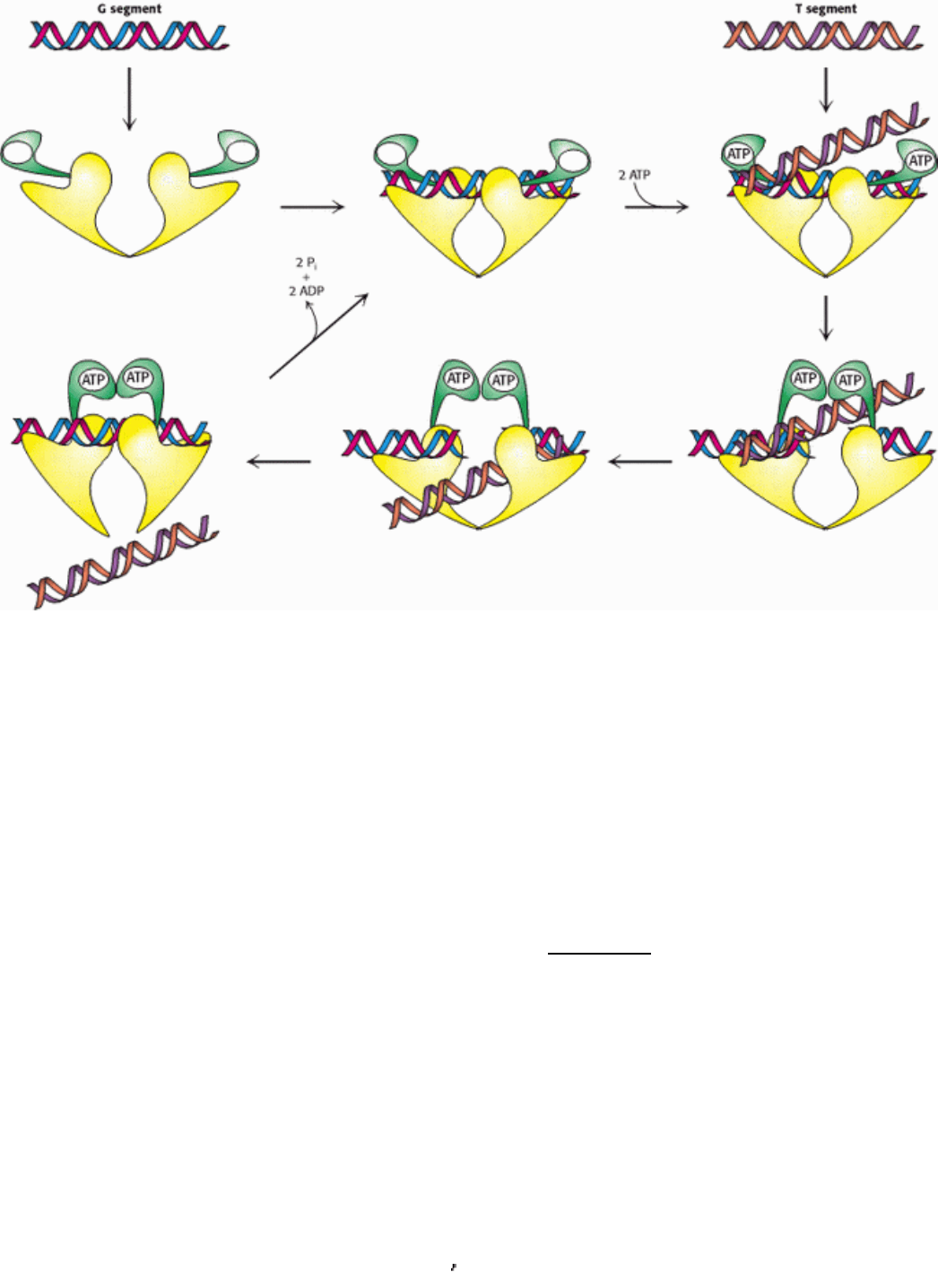
Figure 27.24. Topoisomerase II Mechanism. Topoisomerase II first binds one DNA duplex termed the G (for gate)
segment. The binding of ATP to the two N-terminal domains brings these two domains together. This conformational
change leads to the cleavage of both strands of the G segment and the binding of an additional DNA duplex, the T
segment. This T segment then moves through the break in the G segment and out the bottom of the enzyme. The
hydrolysis of ATP resets the enzyme with the G segment still bound.
III. Synthesizing the Molecules of Life 27. DNA Replication, Recombination, and Repair
27.4. DNA Replication of Both Strands Proceeds Rapidly from Specific Start Sites
So far, we have met many of the key players in DNA replication. Here, we ask, Where on the DNA molecule does
replication begin, and how is the double helix manipulated to allow the simultaneous use of the two strands as templates?
In E. coli, DNA replication starts at a unique site within the entire 4.8 × 10
6
bp genome. This origin of replication, called
the oriC locus, is a 245-bp region that has several unusual features (Figure 27.25). The oriC locus contains four repeats
of a sequence that together act as a binding site for an initiation protein called dnaA. In addition, the locus contains a
tandem array of 13-bp sequences that are rich in A-T base pairs.
The binding of the dnaA protein to the four sites initiates an intricate sequence of steps leading to the unwinding of the
template DNA and the synthesis of a primer. Additional proteins join dnaA in this process. The dnaB protein is a
helicase that utilizes ATP hydrolysis to unwind the duplex. The single-stranded regions are trapped by a single-stranded
binding protein (SSB). The result of this process is the generation of a structure called the prepriming complex, which
makes single-stranded DNA accessible for other enzymes to begin synthesis of the complementary strands.
27.4.1. An RNA Primer Synthesized by Primase Enables DNA Synthesis to Begin
Even with the DNA template exposed, new DNA cannot be synthesized until a primer is constructed. Recall that all
known DNA polymerases require a primer with a free 3
-hydroxyl group for DNA synthesis. How is this primer formed?
An important clue came from the observation that RNA synthesis is essential for the initiation of DNA synthesis. In fact,

RNA primes the synthesis of DNA. A specialized RNA polymerase called primase joins the prepriming complex in a
multisubunit assembly called the primosome. Primase synthesizes a short stretch of RNA (~5 nucleotides) that is
complementary to one of the template DNA strands (Figure 27.26). The primer is RNA rather than DNA because DNA
polymerases cannot start chains de novo. Recall that, to ensure fidelity, DNA polymerase tests the correctness of the
preceding base pair before forming a new phosphodiester bond (Section 27.2.4). RNA polymerases can start chains de
novo because they do not examine the preceding base pair. Consequently, their error rates are orders of magnitude as
high as those of DNA polymerases. The inge-nious solution is to start DNA synthesis with a low-fidelity stretch of
polynucleotide but mark it "temporary" by placing ribonucleotides in it. The RNA primer is removed by hydrolysis by a
5
3 exonuclease; in E. coli, the exonuclease is present as an additional domain of DNA polymerase I, rather than
being present in the Klenow fragment. Thus, the complete polymerase I has three distinct active sites: a 3
5
exonuclease proofreading activity, a polymerase activity, and a 5
3 exonuclease activity.
27.4.2. One Strand of DNA Is Made Continuously, Whereas the Other Strand Is
Synthesized in Fragments
Both strands of parental DNA serve as templates for the synthesis of new DNA. The site of DNA synthesis is called the
replication fork because the complex formed by the newly synthesized daughter strands arising from the parental duplex
resembles a two-pronged fork. Recall that the two strands are antiparallel; that is, they run in opposite directions. As
shown in Figure 27.3, both daughter strands appear to grow in the same direction on cursory examination. However, all
known DNA polymerases synthesize DNA in the 5
3 direction but not in the 3 5 direction. How then does one
of the daughter DNA strands appear to grow in the 3
5 direction?
This dilemma was resolved by Reiji Okazaki, who found that a significant proportion of newly synthesized DNA exists
as small fragments. These units of about a thousand nucleotides (called Okazaki fragments) are present briefly in the
vicinity of the replication fork (Figure 27.27). As replication proceeds, these fragments become covalently joined
through the action of DNA ligase (Section 27.4.3) to form one of the daughter strands. The other new strand is
synthesized continuously. The strand formed from Okazaki fragments is termed the lagging strand, whereas the one
synthesized without interruption is the leading strand. Both the Okazaki fragments and the leading strand are synthesized
in the 5
3 direction. The discontinuous assembly of the lagging strand enables 5 3 polymerization at the
nucleotide level to give rise to overall growth in the 3
5 direction.
27.4.3. DNA Ligase Joins Ends of DNA in Duplex Regions
The joining of Okazaki fragments requires an enzyme that catalyzes the joining of the ends of two DNA chains. The
existence of circular DNA molecules also points to the existence of such an enzyme. In 1967, scientists in several
laboratories simultaneously discovered DNA ligase. This enzyme catalyzes the formation of a phosphodiester bond
between the 3
hydroxyl group at the end of one DNA chain and the 5 -phosphate group at the end of the other (Figure
27.28). An energy source is required to drive this thermodynamically uphill reaction. In eukaryotes and archaea, ATP is
the energy source. In bacteria, NAD
+
typically plays this role. We shall examine the mechanistic features that allow
these two molecules to power the joining of two DNA chains.
DNA ligase cannot link two molecules of single-stranded DNA or circularize single-stranded DNA. Rather, ligase seals
breaks in double-stranded DNA molecules. The enzyme from E. coli ordinarily forms a phosphodiester bridge only if
there are at least several base pairs near this link. Ligase encoded by T4 bacteriophage can link two blunt-ended double-
helical fragments, a capability that is exploited in recombinant DNA technology.
Let us look at the mechanism of joining, which was elucidated by I. Robert Lehman (Figure 27.29). ATP donates its
activated AMP unit to DNA ligase to form a covalent enzyme-AMP (enzyme-adenylate) complex in which AMP is linked
to the ε-amino group of a lysine residue of the enzyme through a phosphoamide bond. Pyrophosphate is concomitantly
released. The activated AMP moiety is then transferred from the lysine residue to the phosphate group at the 5
terminus

of a DNA chain, forming a DNA-adenylate complex. The final step is a nucleophilic attack by the 3 hydroxyl group at
the other end of the DNA chain on this activated 5
phosphorus atom.
In bacteria, NAD
+
instead of ATP functions as the AMP donor. NMN is released instead of pyrophosphate. Two high-
transfer-potential phosphoryl groups are spent in regenerating NAD
+
from NMN and ATP when NAD
+
is the adenylate
donor. Similarly, two high-transfer-potential phosphoryl groups are spent by the ATP-utilizing enzymes because the
pyrophosphate released is hydrolyzed. The results of structural studies revealed that the ATP- and NAD
+
-utilizing
enzymes are homologous even though this homology could not be deduced from their amino acid sequences alone.
27.4.4. DNA Replication Requires Highly Processive Polymerases
Enzyme activities must be highly coordinated to replicate entire genomes precisely and rapidly. A prime example is
provided by DNA polymerase III holoenzyme, the enzyme responsible for DNA replication in E. coli. The hallmarks of
this multisubunit assembly are its very high catalytic potency, fidelity, and processivity. Processivity refers to the ability
of an enzyme to catalyze many consecutive reactions without releasing its substrate. The holoenzyme catalyzes the
formation of many thousands of phosphodiester bonds before releasing its template, compared with only 20 for DNA
polymerase I. DNA polymerase III holoenzyme has evolved to grasp its template and not let go until the template has
been completely replicated. A second distinctive feature of the holoenzyme is its catalytic prowess: 1000 nucleotides are
added per second compared with only 10 per second for DNA polymerase I. This acceleration is accomplished with no
loss of accuracy. The greater catalytic prowess of polymerase III is largely due to its processivity; no time is lost in
repeatedly stepping on and off the template.
Processive enzyme
From the Latin procedere, "to go forward."
An enzyme that catalyzes multiple rounds of elongation or digestion
of a polymer while the polymer stays bound. A distributive enzyme,
in contrast, releases its polymeric substrate between successive
catalytic steps.
These striking features of DNA polymerase III do not come cheaply. The holoenzyme consists of 10 kinds of
polypeptide chains and has a mass of ~900 kd, nearly an order of magnitude as large as that of a single-chain DNA
polymerase, such as DNA polymerase I. This replication complex is an asymmetric dimer (Figure 27.30). The
holoenzyme is structured as a dimer to enable it to replicate both strands of parental DNA in the same place at the same
time. It is asymmetric because the leading and lagging strands are synthesized differently. A τ
2
subunit is associated
with one branch of the holoenzyme; γ
2
and (δ δ χ ψ)
2
are associated with the other. The core of each branch is the
same, an α ε θ complex. The α subunit is the polymerase, and the ε subunit is the proofreading 3
5 exonuclease.
Each core is catalytically active but not processive. Processivity is conferred by β
2
and τ
2
.
The source of the processivity was revealed by the determination of the three-dimensional structure of the β
2
subunit
(Figure 27.31). This unit has the form of a star-shaped ring. A 35-Å-diameter hole in its center can readily accommodate
a duplex DNA molecule, yet leaves enough space between the DNA and the protein to allow rapid sliding and turning
during replication. A catalytic rate of 1000 nucleotides polymerized per second requires the sliding of 100 turns of
duplex DNA (a length of 3400 Å, or 0.34 µm) through the central hole of β
2
per second. Thus, β
2
plays a key role in
replication by serving as a sliding DNA clamp.
27.4.5. The Leading and Lagging Strands Are Synthesized in a Coordinated Fashion
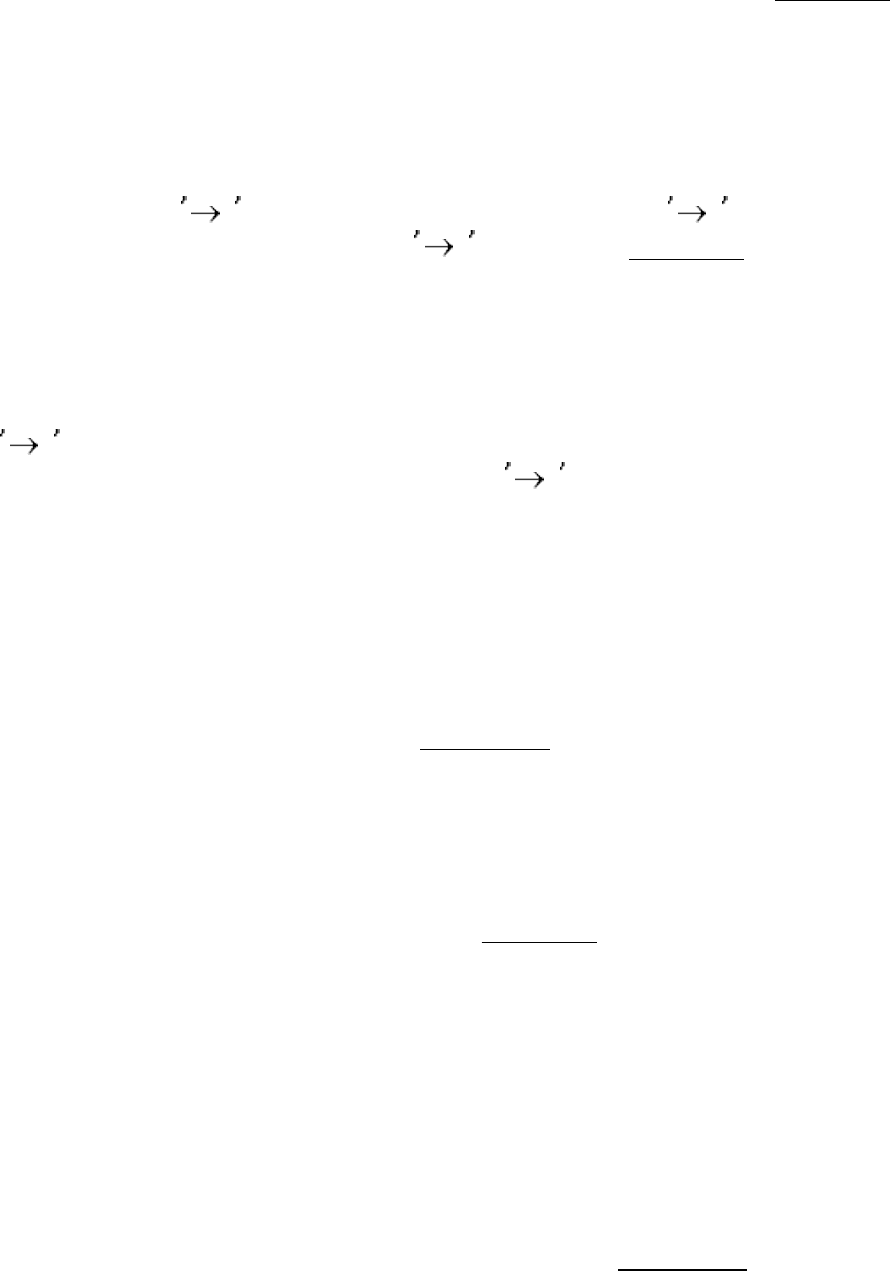
The holoenzyme synthesizes the leading and lagging strands simultaneously at the replication fork (Figure 27.32). DNA
polymerase III begins the synthesis of the leading strand by using the RNA primer formed by primase. The duplex DNA
ahead of the polymerase is unwound by an ATP-driven helicase. Single-stranded binding protein again keeps the strands
separated so that both strands can serve as templates. The leading strand is synthesized continuously by polymerase III,
which does not release the template until replication has been completed. Topoisomerases II (DNA gyrase) concurrently
introduces right-handed (negative) supercoils to avert a topological crisis.
The mode of synthesis of the lagging strand is necessarily more complex. As mentioned earlier, the lagging strand is
synthesized in fragments so that 5
3 polymerization leads to overall growth in the 3 5 direction. A looping of
the template for the lagging strand places it in position for 5
3 polymerization (Figure 27.33). The looped lagging-
strand template passes through the polymerase site in one subunit of a dimeric polymerase III in the same direction as
that of the leading-strand template in the other subunit. DNA polymerase III lets go of the lagging-strand template after
adding about 1000 nucleotides. A new loop is then formed, and primase again synthesizes a short stretch of RNA primer
to initiate the formation of another Okazaki fragment.
The gaps between fragments of the nascent lagging strand are then filled by DNA polymerase I. This essential enzyme
also uses its 5
3 exonuclease activity to remove the RNA primer lying ahead of the polymerase site. The primer
cannot be erased by DNA polymerase III, because the enzyme lacks 5
3 editing capability. Finally, DNA ligase
connects the fragments.
27.4.6. DNA Synthesis Is More Complex in Eukaryotes Than in Prokaryotes
Replication in eukaryotes is mechanistically similar to replication in prokaryotes but is more challenging for a number of
reasons. One of them is sheer size: E. coli must replicate 4.8 million base pairs, whereas a human diploid cell must
replicate 6 billion base pairs. Second, the genetic information for E. coli is contained on 1 chromosome, whereas, in
human beings, 23 pairs of chromosomes must be replicated. Finally, whereas the E. coli chromosome is circular, human
chromosomes are linear. Unless countermeasures are taken (Section 27.4.7), linear chromosomes are subject to
shortening with each round of replication.
The first two challenges are met by the use of multiple origins of replication, which are located between 30 and 300 kbp
apart. In human beings, replication requires about 30,000 origins of replication, with each chromosome containing
several hundred. Each origin of replication represents a replication unit, or replicon. The use of multiple origins of
replication requires mechanisms for ensuring that each sequence is replicated once and only once. The events of
eukaryotic DNA replication are linked to the eukaryotic cell cycle (Figure 27.34). In the cell cycle, the processes of DNA
synthesis and cell division (mitosis) are coordinated so that the replication of all DNA sequences is complete before the
cell progresses into the next phase of the cycle. This coordination requires several checkpoints that control the
progression along the cycle.
The origins of replication have not been well characterized in higher eukaryotes but, in yeast, the DNA sequence is
referred to as an autonomously replicating sequence (ARS) and is composed of an AT-rich region made up of discrete
sites. The ARS serves as a docking site for the origin of replication complex (ORC). The ORC is composed of six
proteins with an overall mass of ~400 kd. The ORC recruits other proteins to form the prereplication complex. Several of
the recruited proteins are called licensing factors because they permit the formation of the initiation complex. These
proteins serve to ensure that each replicon is replicated once and only once in a cell cycle. How is this regulation
achieved? After the licensing factors have established the initiation complex, these factors are marked for destruction by
the attachment of ubiquitin and subsequently destroyed by proteasomal digestion (Section 23.2.2).
DNA helicases separate the parental DNA strands, and the single strands are stabilized by the binding of replication
protein A, a single-stranded- DNA-binding protein. Replication begins with the binding of DNA polymerase α , which is
the initiator polymerase. This enzyme has primase activity, used to synthesize RNA primers, as well as DNA polymerase
activity, although it possesses no exonuclease activity. After a stretch of about 20 deoxynucleotides have been added to

the primer, another replication protein, called protein replication factor C (RFC), displaces DNA polymerase α and
attracts proliferating cell nuclear antigen (PCNA). Homologous to the β
2
subunit of E. coli polymerase III, PCNA then
binds to DNA polymerase δ. The association of polymerase δ with PCNA renders the enzyme highly processive and
suitable for long stretches of replication. This process is called polymerase switching because polymerase δ has replaced
polymerase α. Polymerase δ has 3
5 exonuclease activity and can thus edit the replicated DNA. Replication
continues in both directions from the origin of replication until adjacent replicons meet and fuse. RNA primers are
removed and the DNA fragments are ligated by DNA ligase.
27.4.7. Telomeres Are Unique Structures at the Ends of Linear Chromosomes
Whereas the genomes of essentially all prokaryotes are circular, the chromosomes of human beings and other eukaryotes
are linear. The free ends of linear DNA molecules introduce several complications that must be resolved by special
enzymes. In particular, it is difficult to fully replicate DNA ends, because polymerases act only in the 5
3 direction.
The lagging strand would have an incomplete 5
end after the removal of the RNA primer. Each round of replication
would further shorten the chromosome.
The first clue to how this problem is resolved came from sequence analyses of the ends of chromosomes, which are
called telomeres (from the Greek telos, "an end"). Telomeric DNA contains hundreds of tandem repeats of a
hexanucleotide sequence. One of the strands is G rich at the 3
end, and it is slightly longer than the other strand. In
human beings, the repeating G-rich sequence is AGGGTT.
The structure adopted by telomeres has been extensively investigated. Recent evidence suggests that they may form large
duplex loops (Figure 27.35). The single-stranded region at the very end of the structure has been proposed to loop back
to form a DNA duplex with another part of the repeated sequence, displacing a part of the original telomeric duplex. This
looplike structure is formed and stabilized by specific telomere-binding proteins. Such structures would nicely protect
and mask the end of the chromosome.
27.4.8. Telomeres Are Replicated by Telomerase, a Specialized Polymerase That
Carries Its Own RNA Template
How are the repeated sequences generated? An enzyme, termed telomerase, that executes this function has been purified
and characterized. When a primer ending in GGTT is added to the human enzyme in the presence of deoxynucleoside
triphosphates, the sequences GGTTAGGGTT and GGTTAGGGTTAGGGTT, as well as longer products, are generated.
Elizabeth Blackburn and Carol Greider discovered that the enzyme contains an RNA molecule that serves as the
template for elongation of the G-rich strand (Figure 27.36). Thus, the enzyme carries the information necessary to
generate the telomere sequences. The exact number of repeated sequences is not crucial.
Subsequently, a protein component of telomerases also was identified. From its amino acid sequence, this component is
clearly related to reverse transcriptases, enzymes first discovered in retroviruses that copy RNA into DNA. Thus,
telomerase is a specialized reverse transcriptase that carries its own template. Telomeres may play important roles in
cancer-cell biology and in cell aging.
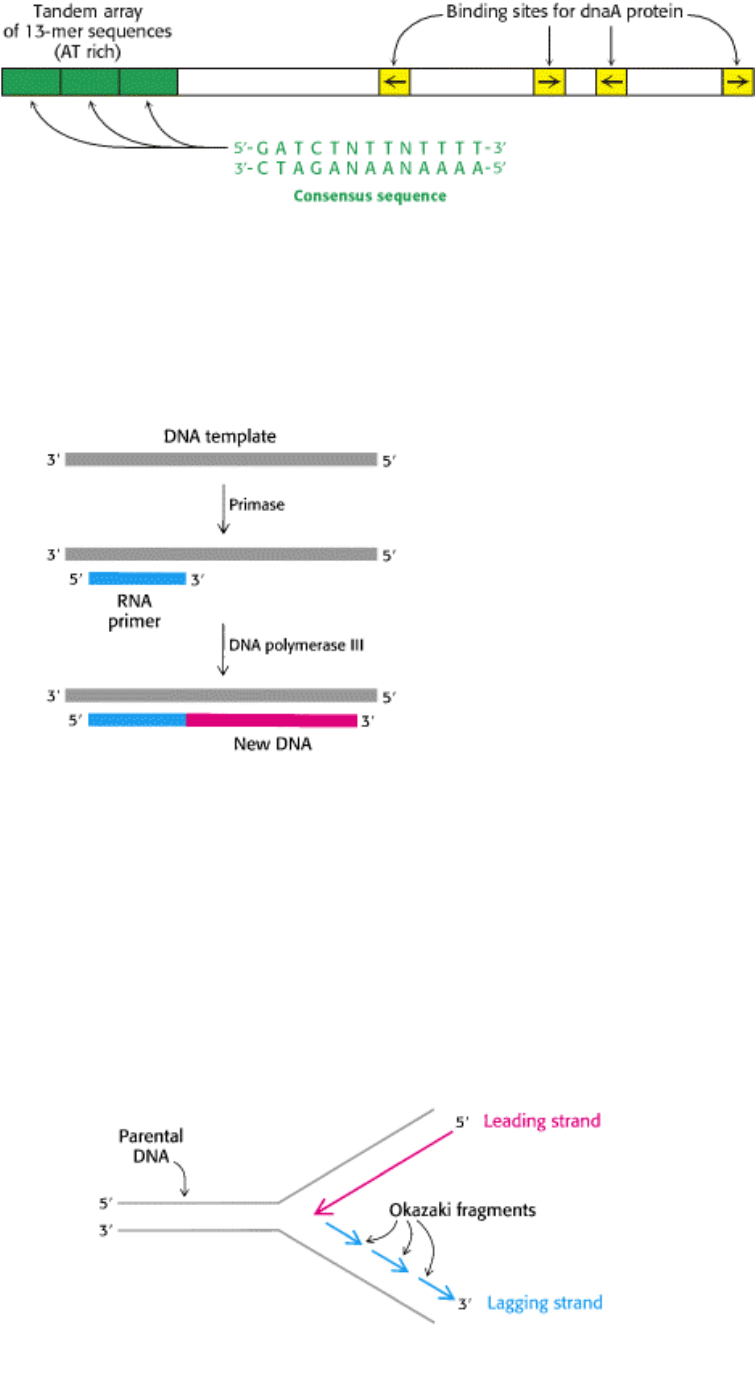
III. Synthesizing the Molecules of Life 27. DNA Replication, Recombination, and Repair 27.4. DNA Replication of Both Strands Proceeds Rapidly from Specific Start Sites
Figure 27.25. Origin of Replication in E. coli. OriC has a length of 245 bp. It contains a tandem array of three nearly
identical 13-nucleotide sequences (green) and four binding sites (yellow) for the dnaA protein. The relative orientations
of the four dnaA sites are denoted by arrows.
III. Synthesizing the Molecules of Life 27. DNA Replication, Recombination, and Repair 27.4. DNA Replication of Both Strands Proceeds Rapidly from Specific Start Sites
Figure 27.26. Priming. DNA replication is primed by a short stretch of DNA that is synthesized by primase, an RNA
polymerase. The RNA primer is removed at a later stage of replication.
III. Synthesizing the Molecules of Life 27. DNA Replication, Recombination, and Repair 27.4. DNA Replication of Both Strands Proceeds Rapidly from Specific Start Sites
